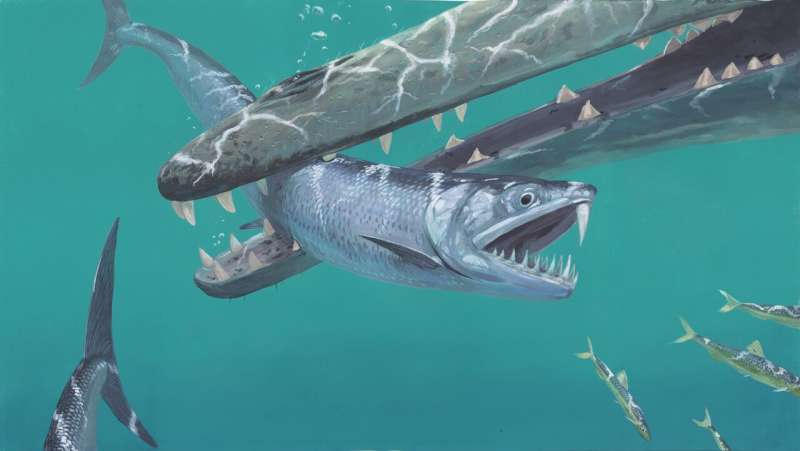May 13, 2020 report
Prehistoric anchovy-like fish had large fangs and a saber tooth

A small international team of researchers has found that two prehistoric anchovy-like fish had fangs and a saber tooth. In their paper published in the journal Royal Society Open Science, the group describes their study of the ancient fish and provides some theories about why the fish evolved such remarkable features.
As the researchers note, prior research efforts have led to finding a host of fossilized fish remains that have been dated back to the early Palaeogene—many of which were clearly predatory. This has led scientists to conclude that such fish likely evolved into more predatory forms after larger predators were killed off by the same asteroid that killed off the dinosaurs.
In this new effort, the researchers examined two such cranial fossil specimens that have been housed at the Royal Belgian Institute of Natural Sciences, in Brussels, Belgium. One of the ancient fish fossils was found in Belgium (in a rock formation near Chièvres) the other in Pakistan's Punjab province—both were dated to approximately 41 to 54 million years ago. Each of specimens had a single saber tooth at the front of its mouth and both had fangs, though they were much larger on one of the specimens.
The researchers noted that both specimens bore a strong resemblance to modern anchovies, though they were much larger. Modern anchovies are smaller, on average just 15 centimeters, and they have small teeth that they use to eat plankton. Both fish clearly evolved to become predators, likely as a result of a niche opening up in their environment due to the sudden disappearance of larger predatory fish. There is no evidence of either fish type surviving to modern times. The researchers suggest the saber tooth was likely used to impale prey, a more efficient way of feeding than catching them.
The work by the team involved placing the cranial fossils in a micro-computed tomography machine and interpreting the results, with most of their focus on the skull bones and teeth. Doing so revealed the structure of the head and also allowed the researchers to estimate the size of the fish—one would have been approximately 1 meter long, the other approximately half that length.
More information: Alessio Capobianco et al. Large-bodied sabre-toothed anchovies reveal unanticipated ecological diversity in early Palaeogene teleosts, Royal Society Open Science (2020). DOI: 10.1098/rsos.192260
Journal information: Royal Society Open Science
© 2020 Science X Network





















